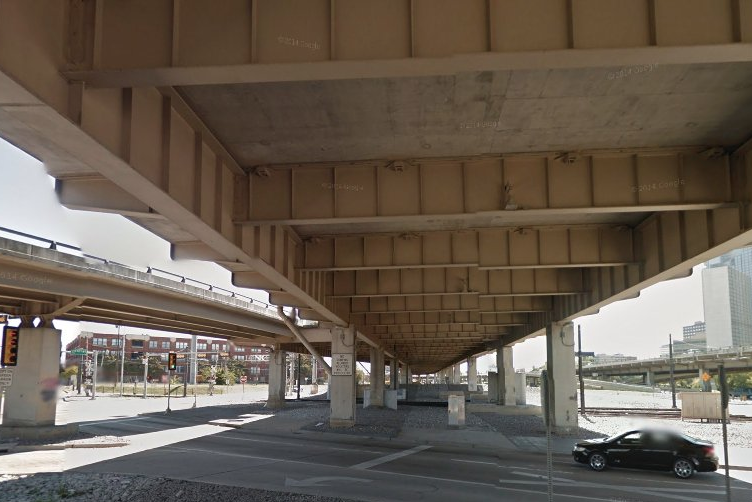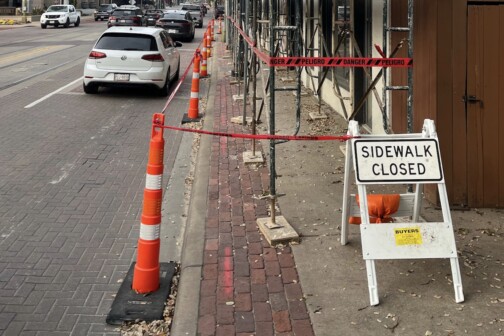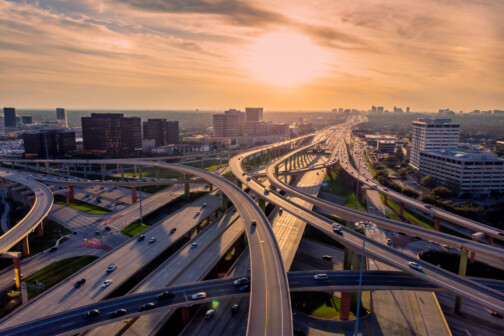When I first read this op-ed about I-345 that appeared in last Sunday’s Dallas Morning News, I was flummoxed. Blame it on I-345 fatigue, which breeds a kind of paranoid defensiveness similar to Trinity River Corridor Project PTSD. Mention either of these projects, particularly within the pages of the DMN, and my back instinctively spikes up like a porcupine.
The piece is by Michael Grace, the assistant city manager and chief operating officer for the city of Ferris, and he writes that I-345 is a “very important regional transportation corridor” and that “removing this transportation connection, within a competitive, polycentric, still maturing urban region, would have a wide ranging impact that would reverberate across the entire city.”
Polycentric urban region? Very important corridor? Urbanism blasphemy!
But by the time I got to the end of Grace’s piece, the more I saw that he was trying to call out some aspects of the I-345 removal that truly do need more attention. Grace seems to agree that there are a lot of benefits to removing I-345 and replacing it with a boulevard and a reconstructed urban street grid. But he also offers a warning. Tearing down an urban highway is one thing. Making sure what replaces it is worthy of the effort is something else entirely.
“Simply removing this bit of highway, as some have proposed, will not bring those neighborhoods back to life nor magically create equitable and sustainable development,” he writes.
He’s right, of course, though with one caveat. I don’t believe anyone is proposing we should simply remove the highway without doing anything else. In fact, the entire point of TxDOT’s CityMAP study, a mention of which is conspicuously absent from Grace’s op-ed, was to help establish a framework to think about the very things he advocates for, like carefully considering policies around “affordable housing, traffic, alternative transportation, land use, and much more” to direct development after the highway is removed. (CityMAP explored the city’s relationship with its highways and how design elements could encourage economic development and repair the damage they caused to urban neighborhoods.)
But Grace is correct that the city hasn’t shown a ton of impetus, to date, in getting out ahead of any future work on I-345. And there is much work to be done. Grace points out a need for more planning that addresses capacity highway loop routes, not only for redirected commuter traffic but, more important, inter-regional truck traffic.
There also needs to be more planning around how to re-stitch the street grid and manage urban traffic through the area freed up by the removal of I-345. The only concrete plan we’ve seen is the inadequate one TxDOT sketched out within its I-345 alternatives study. I would also add that there should be a plan that addresses how a re-stitched grid could affect or improve public transit access in the area.
Grace also argues that the conversation around neighborhood development should expand beyond the neighbors and business representatives in the immediate vicinity of the elevated freeway. He calls for the inclusion of neighborhoods and suburbs—perhaps, like Ferris—that will also be impacted by the project. Surely Grace knows that some of this outreach work was done, once again, during the CityMAP process.
According to his LinkedIn, Grace participated in a working group with the Greater Dallas Planning Council that was established to make recommendations on CityMAP. But the point is also well taken. Widespread buy-in will require widespread community participation, particularly on an issue that is so impactful and yet counterintuitive as removing an urban highway.
Grace’s piece challenges the city to work to create a mixed-income community that also supports the proliferation of new small businesses. That, too, will require the kinds of carefully crafted policies that the city of Dallas doesn’t have a long track record of producing. What is more likely to happen, Grace warns, is that the redevelopment will be left to dominant economic forces, which will produce something resembling a new Uptown. If that happens, then the great promise of transforming an urban highway into an urban neighborhood will fail at one of its main goals: reducing transportation inequality.
“Commuting across town isn’t the ideal approach to affordable housing, but right now, it’s one of the few options,” Grace writes. “Changing this dynamic will require focused, progressive economic development and urban design policies, standards, and strategies for a more equitable region, benefiting diverse community stakeholders.”
The timing of Grace’s op-ed is curious. Things have been quiet on the I-345 front; TxDOT is focused on moving the I-30 rebuild ahead. Even though the Biden administration’s infrastructure bill includes money for highway teardown projects, I-345 was not listed as one of Mayor Eric Johnson’s priorities for federal funding in his letter to Transportation Secretary Pete Buttigieg.
And yet perhaps that is why now is a good time to remind the city that the success of an I-345 teardown rests on the kind of work done during these quiet months and years. A cohesive, comprehensive, and coherent strategy to community and economic development around I-345 needs to be in place before dirt is turned.
“It is imperative that I-345 not be treated as simply a real estate play,” Grace argues. “Any plan to demolish I-345 in hopes of inducing redevelopment and restitching the street grid must be guided by plans that ensure equitable outcomes. This commitment must be kept at the forefront of all discussions and any option chosen as the solution.”
CityMAP started this discussion, and I wish Grace had acknowledged this. But the discussion needs to continue. Furthermore, the project needs champions both within Dallas and from outside suburbs—representatives like Grace, in fact—to help improve awareness and understanding of the large planning impacts of an inner-city highway teardown.
And while I agree with Grace that we need the kinds of educational outreach and policy initiatives “that will allow the region to mature,” I don’t believe the goal is to arrive at a place where, as he puts it, “this important highway link is no longer needed.”
After all, a big problem with urban highways is perception. As long as the highway is there, it will be perceived to be important and necessary. It’s a chicken-and-egg issue. The highway is already no longer needed, and we need to tear it down. But we also have to be ready for what comes next.
Get the D Brief Newsletter
Author






